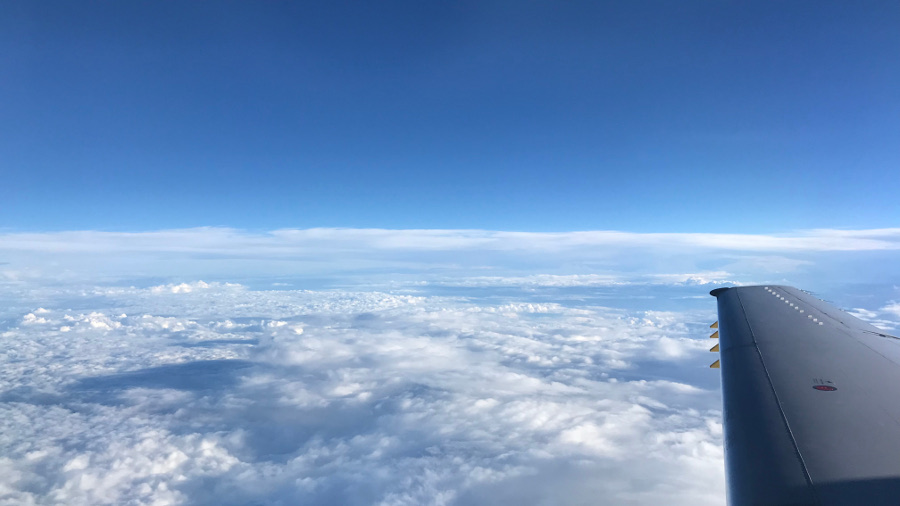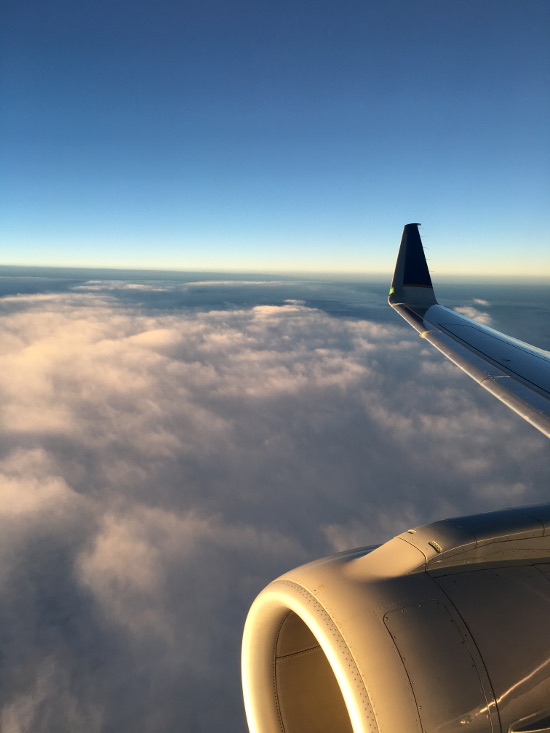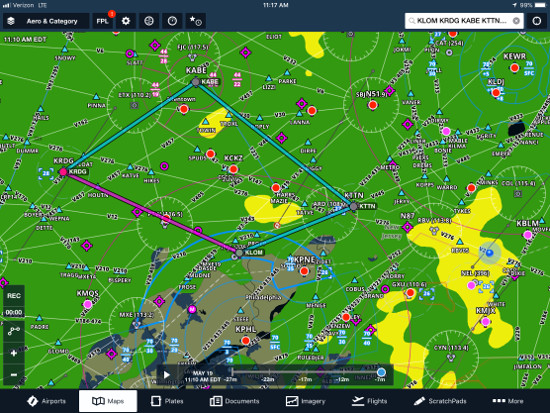My Journey To The Airlines
Page 1 of 4

An Embraer 145 LR in High Altitude Cruise
Backstory
Back in 1987 when I was 17 years old I promised my parents that if they invested in my chosen college education that I would follow through and become an airline pilot. While I was ultimately forced to change careers in 1995 and move into the tech industry, since that time I always kept one foot in the industry, flying and working on my own aircraft, serving stints as a CFI and commercial pilot, and adding certificates and ratings to keep me sharp.

In 2005 I made the decision to pursue the doctorate of aviation, otherwise known as the Airline Transport Pilot certificate. You can read about that experience here. Of course at the time my title of "Airline Pilot" was limited to the name of the certificate I held because I was working at my second startup in the tech industry and not really interested in flying for the airlines, who were at that time still reeling from the effects of 9/11.
Then in 2009 Colgan Air 3407 crashed in Buffalo. The investigation revealed so many issues with that flight that it became a benchmark case in aviation safety. The investigation ended with outrage on the part of the families who lost loved ones, to the point that Congress forced the FAA to pass several new regulations governing rest rules and minimum experience for ATPs. These rules dramatically increased the cost for a pilot to get to the cockpit of an airliner, and when combined with the after-effects of 9/11 this reduced the pool of pilots willing and able to endure the hardships typical at the regional airlines.
Predictably, by 2015 airlines found themselves short of pilots and so began hiring in earnest. To attract candidates they started offering to pay for training, much as they did during the 1960s, which many regard as the golden age of airline operations. More recently they resorted to providing sign-on bonuses of $20K+ or more, particularly to those with prior experience in Part 121 operations.
Fast forward to the fall of 2017. I had been working in my own company for several years trying to pivot it from a job shop to one based on products produced in house. That task was taller than I expected, and I found myself in need of extra money to continue development of several products. I was also tired of paying for overpriced healthcare out of pocket. While I could have gone to work for another tech company I needed a job that would not require me to sign any IP assignment agreements that would necessarily rob me of my rights to my own inventions.
One day a friend called me and asked whether I had been paying attention to the state of the aviation industry and I admitted I had not. That spurred an on-and-off research project, following which I concluded that this was probably the best time to enter the industry since I became a pilot, so I decided to put my piloting skills to use once again and attempt to get hired by an airline.
Following several months of preparation I was hired in July 2018 and began my first airline training program. Sadly, this process unexpectedly resulted in my first checkride failure and unceremonious termination from that company. However, I persevered and ultimately succeeded. Just a few weeks afterward I was hired by another company. In late January 2019 I passed the checkride and acquired a type rating in the Embraer 145. I now work as a pilot for that airline.
This is the detailed story of what happened over a period of roughly 10 months and what I learned from it. I'll warn you up front that this is a very long article -- indeed the longest on this site by far -- but if you're thinking of applying to the regional airlines or getting a job in the industry in general, I think you'll find this helpful.
Return to the Cockpit
The airplane I flew for many years was sold in 2011 so my greatest fear in going back to the industry after seven years was whether I could still muster my flying skills. I was at one point quite proficient in IFR, including a multi-crew environment, but now I was just another guy trying to get back up to speed.
I began my studies in early March 2018, beginning with renewing my CFI, which was due in just a few short months. While there wasn't really anything new to learn here it did help review the basics and I knew it would supplant the 1 hour ground requirement of the flight review to come. It took me about four days to get through the 16 hour course and I soon had my temporary certificate in hand.
Due to the extreme demand for flight training, ironically caused by the rush of airline hiring, I found it quite difficult to nail down a decent airplane and instructor, to the point that I was forced to drive about an hour and a half to Fly Advanced at Wings Field in Pennsylvania for every lesson. While the drive was an unwanted burden I'm glad I went there because the FBO, instructor and airplane were all top-notch.

Despite the aircraft being substantially newer than the model I'd flown for years, I found it quite familiar. I briefed the taxi and takeoff procedures much as I had been trained to do in prep for my ATP, and set out to the practice area to do a litany of maneuvers beginning with s-turns across a road, steep turns, and the stall series.
A simulated engine failure followed and I controlled the energy of the aircraft much as I'd been taught at Daniel Webster 30 years ago. I briefed the approach and touchdown point, adjusted speed to manipulate the angle of descent, smoothly touched down on point and turned off without using brakes. As I crossed the hold short line the instructor complemented me and in response I joked "thanks...not bad for a guy who hasn't touched a yoke in seven years!" Despite having reviewed my logbooks and discussing how long I'd been out of the industry he said "Seven years, huh? You fly better than a lot of current pilots I know!" The served as a confidence booster as well as confirmation of my long-standing belief that once you get to a certain experience level you never forget how to fly. Naturally, I received a flight review signoff at the end of the hour-long lesson.
Subsequent lessons dealt with IFR procedures and it was at this point I discovered my weakness -- a rusty instrument scan with a tendency to fixate. This proved once again that instrument skills are perishable to a greater extent than basic flying skills, but the good news is I was still proficient on the Garmin 430s installed in the panel so we quickly got through all of the basics, including holding procedures, and he signed me off for an IPC in a couple hours.
Continuing my longstanding policy to be over-prepared for everything I do, I booked a few more flights with the instructor, mostly to have him serve as a proficient safety pilot. We managed to fly in actual and, as luck would have it, on the last planned flight, in extremely gusty and turbulent conditions. My goal that day was to do nothing but ILS approaches to minimums so you can probably imagine my enthusiasm as we flew over the marker on our first ILS24 into Philadelphia Northeast airport and hearing tower call "windshear advisories are now in effect", the result of a King Air experiencing +/- 20K on short final and ultimately going around.
We were getting bumped around pretty good below 500 feet and at times I found it difficult to keep the instruments stationary in my field of view. But I fell back on my long experience and resisted the urge to death-grip the yoke. Instead, I rested my hand on my knee for stability and used finger tips on the corner of the yoke to smoothly correct each deviation and fly the approaches typically within needle-width tolerances. By the end of that flight I knew I'd earned my right to interview with an airline so I thanked the instructor one last time and drove home with a confidence I hadn't felt in years.
Research and Company Selection
I first considered flying for a smaller Part 135 (Non-Scheduled / Charter) or 91K (Fractional Ownership) operator to gain experience but I couldn't find the right blend of aircraft, pay, schedule and base in those business segments. On top of that I read what I considered horror stories with regard to the scope of duties, length of the duty day and number of legs so I then turned my attention to the regional airlines.
I quickly learned that some regionals were wholly owned by a major carrier (Piedmont, PSA, Envoy, Endeavor), some where partially owned by a major (Republic, Commutair) and others were more or less independent companies that were contracted to provide service to one or more major airlines (Air Wisconsin, SkyWest, Horizon, TSA, GoJet). I also confirmed what I'd learned many years ago -- that the regionals had largely abandoned turboprops and had moved to 50 seat jets.
Most pilots on the forums seemed to favor the Embraer 145 and newer 76 seat Embraer 175 as they generally had better performance than the CRJ equivalents. I then analyzed each company by aircraft, pay, bases near my home, and work rules. Eventually I narrowed down my choice to a singular company which just so happened to fly the desirable Embraer 170/175 in 69 and 76 seat configurations respectively.
Interview Prep
I then went to the company's HR site to determine the application prerequisites. I met all of the criteria except that I didn't have a current passport so I went to my local county passport office with the forms filled out and about 5 weeks later picked up the certified mail with the passport enclosed.
Although I already had my ATP I had taken the written test over 10 years prior so I knew some review was in order. While I was waiting for the passport to arrive I purchased the Sheppard Air Airline Interview Prep course for $50 based on feedback from many people. Given my background in software engineering I cringed at the application's poorly designed user interface but found the content and study methods useful.
The Interview Prep course was reportedly developed using feedback from people who had taken written tests as part of the interview process at various regional airlines, but my impression was that most if not all of the questions came from the ATP written test bank, so I think it's fair to say that the only practical difference between the Sheppard Air Interview Prep and regular ATP written test prep courses is that the ATP written version has all of the questions in the test bank while the Interview Prep has a more manageable (~800 question) subset.
I spent the better part of three weeks going through the Prep Course questions several times and in accordance with the study guide. While it was certainly possible to simply read the question and memorize the answers I used many of the questions as a means to more deeply research a variety of topics including high altitude weather and aerodynamics that I knew I might need to explain in detail during the interview. This did take extra time but I found myself over-prepared for the interview, and that led to a confidence that I think was primarily responsible for my success in the interview process.
Reading the Airline Pilot Central (APC) Forums I noticed that every time someone asked for an Interview gouge they would point people at AirlineInterviews.com. Now I'll say up front that I used to review this site just for fun 10+ years ago. I was not particularly impressed with its user interface at that time but it was free so I didn't care.
The problem is at some point the owner of the site decided to put up a paywall and start charging what I consider to be predatory prices for access to information that could just as easily be posted and read for free on APC Forums -- or any other forum for that matter. I subscribed to the site thinking that the owner must be hiding a decent UI behind the paywall but I was wrong. I found essentially the same shitty UI I'd seen years ago, only my wallet was lighter. Disturbingly, I found the gouges could not be meaningfully searched or sorted, and worse, there was no means for threaded user commentary on the gouges, as is inherently supported in common forum software. The site was so frustrating to use I got what I needed from it and never visited it again.
To add insult to injury the site tried to charge my credit card for the second month without warning but I had heard about this practice and put in place a means to thwart the charge attempt. I let the subscription die a deserving death, convinced that the site is pretty much the poster-child for how not to design and run a website. My advice is to go there if you think it will give you an edge on the interview, but please submit your gouge to APC forums and then donate $20-30 there. That site is far more worthy of your money and you'll likely find it useful long after your interview.
I have to admit that I was a bit nervous about interviewing as I hadn't interviewed at any company in nearly 15 years and that was for a tech startup that told me "don't bother dressing up -- we don't care about that". A hint to anyone coming into the aviation industry from the tech world -- airlines are old school and do very much care about your attire when you show up. While it is technically true that some airlines suggest "dress casual" is acceptable (meaning slacks, dress shoes and a button-down shirt without a tie), everyone in my interview group were wearing suits...including me. To give the best impression I bought a new suit and had it tailored. The process took about a week.
I also purchased a new four wheel roller bag. My current roller was a two wheel unit I'd bought many years ago and it looked pretty ragged if I'm honest. My research revealed that Briggs and Riley had a great reputation among the traveling public as well as airline crew and when I learned they would give airline crewmembers a 20% discount it was a done deal. More about this purchase later.
The Interview
Once I had all my ducks in a row I submitted an application to my first choice company. They contacted me a couple days later to set up an on-site interview, and give me travel and lodging information. This was actually the first time I realized how much had changed in the industry. In the not too distant past airlines would expect you to find your own way to the interview, pay for the ticket and any hotel if necessary. This airline sent me a positive space ticket that allowed me to arrive the night before the interview and paid for the hotel so that I would be properly rested when I arrived first thing the following morning. Interestingly, not all companies bring candidates in the night before -- they force you to take a red eye to arrive just prior to the interview at 8AM. This is, in my opinion, nothing more than an attempt to save money at the the applicant's expense. I wouldn't rule out a company that did this, but it would factor into my decision whether to accept an offer there. After all, if they're that cheap, what else might they scrimp on?
When I arrived at the company's training center I counted 11 other candidates. It didn't take long to find some people to talk to while we waited to be called in to a meeting room where we were then given a short presentation about the company and introduced to the pilots that would be conducting the interviews. The pilots consisted of two very experienced and high seniority captains and the top FO (#1 on the FO seniority list).
I naturally brought my logbooks and other paperwork to the interview as requested and while the captain looked them over an HR rep handed me an iPad for a 20 question written test with a 20 minute time limit. The questions were all present in the Interview Prep course so it took only a few minutes to review and submit my answers and hand the iPad back to the rep. She did not tell me my score. I'm 99% sure I got a 100% but I'll never know for sure. I was to later learn this is par for the course, and at least with this company the score only dictated the extent of the technical interview and not necessarily that I would be dismissed for failing it.
While the captain continued to fan the pages of my logbook the HR rep asked me a bunch of questions including "why this company", "tell me about a time when" and "what is your greatest strength / weakness". Of course they asked me whether I had ever failed a checkride (I hadn't up to that point) so it was with a matter of pride I said "no, absolutely not". They also asked whether I had any kind of criminal record or DUIs and I told them "no" and clarified that the only time I've ever been before a judge was when giving testimony in a motor vehicle accident case and fighting the rare motor vehicle ticket. They naturally had a copy of my driving abstract for the last five years and seeing nothing on it, asked no further questions on the subject.
Overall I felt the interview went well, though the captain approached me a few minutes after the interview and gave me some advice. He said I did fine and that he wouldn't be surprised if I was extended an offer, but he commented that I like to talk. "Guilty as charged" I said with a smile. He said it's a great trait to have but in the Part 121 world less is better, particularly during oral exams. He related an example: if the examiner asks you what EICAS means, you tell him "Engine Instrumentation and Crew Alerting System" and nothing more. If he wants more information, he'll ask, but if you volunteer more information than necessary and perhaps state something less than 100% correct, he'll chase you down that rat hole to expose your weaknesses. I thanked the captain for his advice and went back in the room to have some lunch catered by the company before leaving shortly before noon to catch my flight home.
Conditional Job Offer
Three days after I completed the interview I received what is known in the industry as a conditional job offer (CJO). This letter offers one a job contingent on meeting a bunch of requirements, including the ability to pass a background check, and, if you lack an ATP, satisfy the airline's minimum time requirements before arriving for training.
I already had my ATP so this part was easy for me and mostly
amounted to getting a passport, an FCC restricted radiotelephone
operators license (sorry fellow hams -- as stupid as it sounds,
your amateur radio license will not legally qualify you to
operate a VHF aircraft radio!), and having the FAA reissue my ATP
certificate with an English Proficient endorsement since at the
time I got my ATP this was not the default.
I then received and filled out a bunch of forms that allowed them to ask a variety of government organizations for my life history including a FAA transcript of my certificates and any certificate actions. This is known in the industry as a PRIA request. I knew for a fact I had no skeletons in my closet so the only risk here was that of a false positive, meaning, a record keeping error that had not yet been revealed.
When the time came to select a class date I wound up going with the next available date, which turned out to be a mere 9 days later. Fortunately I had done a lot of prep before this, including buying new clothes, luggage, etc. I'm not sure I could have done everything I needed to do within that timeframe otherwise. So my advice is to be realistic about when you will be ready to travel to indoc, and don't be afraid to select a date at least two weeks away. Most of the people in my class, for example, had interviewed 2-3 months prior.
Travel To Training
Yes, Uber and Lyft are useful tools and they work reasonably well, but there is nothing quite like being able to go where you want, exactly when you want, and not have to wait around for some random driver with a dirty vehicle wreaking of air fresheners to take you where you want to go, or waiting in line for the hotel shuttle. I recommend either driving your own car to the training location or getting a rental car. In my class several people drove their own vehicles and a couple people (including me) had a rental.
A car allowed me to go to the grocery store and buy fresh fruits, nuts and other healthy snacks, create inexpensive lunches with wraps and some lunch meat, as well as obtain takeout from a variety of restaurants that for some reason either didn't deliver or relied on expensive outsourced delivery services like UberEats or DoorDash that typically add $6-8 to every order. It goes without saying but spending $20 for a single meal is just stupid.
While rental cars are not exactly cheap, when I factored in the cost of driving 14 hours each way, the cost of my time to drive there, the wear and tear on my vehicle (800 miles * 2 * $0.35/mile) plus gas, AND factored in the cost savings with regard to food delivery ‐ not to mention the convenience ‐ I considered it a reasonable deal. One perk of being an airline employee is that discounts are available for car rental. I applied the company's partner discount which reduced the cost to $375 for 12 days, and as it turned out the company I used had the worst discount rate of the associated companies, so I knew I'd be able to do better for systems training.
Training Dress Code
Most airlines expect pilots in training to adhere to what they call a "business casual" dress code. Unfortunately, business casual is a rather generic term that means different things to different people in different industries. In the tech industry business casual is a nice set of jeans (no holes, etc.) and a t-shirt with some sneakers. Rest assured, this does NOT fit the definition of business casual for the airlines. They expect a nice set of leather or suede shoes, a pair of slacks and a collared shirt.
Because I could not afford space in my luggage for more than one pair of shoes I kept my lower half black -- black slacks and black shoes. I then brought long sleeve button-down shirts with a variety of subtle patterns, most dark or solid color because that is what I prefer. While I was in training during the summer and our classroom was in the warmest part of the building I did not feel uncomfortable wearing a long sleeve shirt. I also think long sleeve shirts look more formal, and are therefore more consistent with the theme of the job.
While I don't think you'll necessarily be fired for failing to dress correctly, failure to adhere to the dress code sends the wrong message. If you come from an industry steeped in anti-authority sentiment like tech this will be a rude awakening, but a necessary one.
Packing Strategy
I knew I would be leaving for indoc on a Monday and then need exactly 9 days worth of "business casual" attire plus clothes for travel days and the weekend. Given the restrictions for carry-on luggage as well as the fees and hassles associated with checked baggage I decided to develop a clothes and packing strategy that would fit the constraints of one domestic carry on and one personal item.
The best thing I did was purchase an assortment of packing cubes. I selected the Shacke brand mostly because they looked to be reasonably good quality and had sections of mesh that allowed me to see what was in each cube even with the top zipped shut. My interview trip was the first time I used them and they transformed my packing experience, primarily because they made it possible to organize everything and pack (and repack) my bag very quickly. I can't imagine traveling without them now.
I wound up packing three black pants (dress slacks) and six button-down shirts as well as at least six pair of underwear and socks. The strategy was to wear the pants two days in a row and four different shirts for the first week. Then on Friday evening, I'd take the two pairs of pants and four dirty shirts to a dry cleaner. Knowing full well the clothes wouldn't be ready by Monday morning I figured I'd wear the third pair of pants for two days along with my other two shirts. Then I would pick up the dry cleaning on Monday (or Tuesday latest) and have more than enough clothes to get me through the remainder of the week before flying home on the following Saturday. I also packed a pair of jeans and a couple t-shirts and casual shirts since I knew I'd need to wear something while I took all of my laundry to a laundromat on Saturday.
Interestingly, I was able to fit all of this stuff in my Briggs bag, but only when it was fully expanded, so it appears the practical limit to this bag is 6 days worth of clothes and sundries. I should point out, however, that when fully expanded the Briggs bag no longer meets the criteria for a domestic carry on and must be checked -- either at the gate or a drop off point.
Whether any legal domestic carry on bag is gate checked is mostly a function of the aircraft type. For example, I flew on ERJ-145s for my interview and to get to indoc initially. I had to gate check my bag on all of these flights because the bins on the 145 are too small for an otherwise legal domestic carry on. However, when I flew home from indoc I was treated to "company metal" (a ERJ-175 operated by my company). The bins on that aircraft are big enough to accept a legal domestic carry on so most people did not have to gate check. Of course, I did have to gate check my bag even in that case because it was still expanded and hence would not fit in the overhead.
The perk of flying home on company metal was that I was upgraded to first class (or what constitutes first class on a regional) along with several other classmates. To borrow a well-worn marketing slogan: membership has its privileges.





